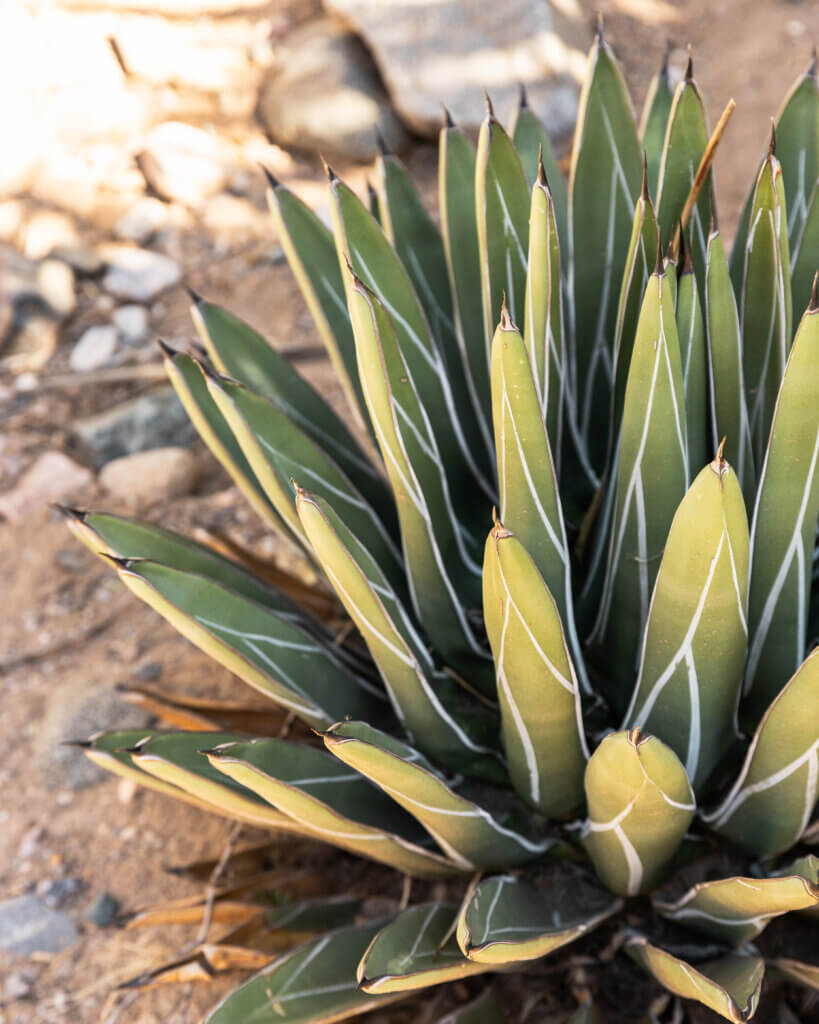How to Care for Succulents and Cacti

If you’re diving into the world of succulents and cacti, we’ve got you covered with essential care tips to ensure your plant pals thrive. In this blog post, we’ll cover these care tips for cultivating happy and healthy succulents:
Light: Is Direct Sunlight or Shade Best?
Many cacti and succulents grow in the shade. Sudden exposure to the sun can give them a sunburn. A sunburn would expose them to infection and rot, eventually leading to it’s death.
Several types of cacti can tolerate direct sun but gradual introduction is the key. Many cacti require nurse plants when they are young. Nurse plants offer shade to young plants until they are more mature and tolerant of direct sunlight.

Watering: Intermittent but Generous
Most cacti and other succulents thrive when provided with intermittent but generous watering. Water them when the top half-inch of the soil is dry. Many cacti can be susceptible to rot in cold conditions if overwatered. Cacti shouldn’t need much water when low temperatures drop below 40 degrees fahrenheit.
Even though these plants are okay with a little drought, most succulents appreciate a good rain shower. Consider the growth of cacti in their native environment. Cacti are more abundant in areas of Arizona receiving 18 inches of rain per year than in areas receiving only 8 inches of rain per year.
Soil Mix: Drainage is Key
Succulents like their soil loose and able to drain well. Avoid water-logged soil because it’s a breeding ground for bacteria. Roots need air and oxygen to live. You may suffocate your succulent’s roots by planting them in heavy clay or super compact soil.
This soil mix works well for succulents: equal parts soil, sand, and peat moss or coconut coir. Adding another equal part of perlite (the heat-expanded kind) gives better aeration and drainage.
Soil Mix:
- 1 part loam or good black soil
- 1 part sand (not from saltwater beaches)
- 1 part peat moss, coco coir or composted bark
- 1 part perlite
- Liquid nutrients as needed
Fertilization: Feeding your Succulents
When feeding your succulents, a liquid 13-6-6 mixture designed for house plants works well. While dry chemical field fertilizers can be used in the soil, a more effective method is adding a small amount of liquid fertilizer to regular watering.
Take note that using a fertilizer that is high in nitrogen usually results in vegetative growth instead of flowering.
Potting: Finding the Perfect Home for Your Plant

Avoid over-potting, as succulents prefer snug spaces. The soil in a pot that is too large dries out slower, which can lead to infections from bacteria breeding in moist soil. The soil should be able to completely dry out in about a week’s time.
Now to cover the two basic types of pots to choose from–clay and plastic. Clay pots dry out faster than plastic ones and allow fresh air to reach the roots. They also keep the soil cooler since it is more insulated and evaporation occurs through the clay pot.
However, faster growth can occur in plastic pots because they allow for varying root temperatures. If you choose to use a plastic pot, you can achieve better aeration in the soil by adding perlite to the soil mix.
For succulents that are difficult to grow, the best choice would be to use a clay pot with plenty of perlite and sterilized soil in your soil mix.
Protection from Insects: Keeping your Plants Bug-Free
Identifying your pest is the key to proper pest treatment.
Many pests can be treated with a simple suffocant that can be made at home with the following recipe:
- 1 tablespoon liquid dish soap
- 1 tablespoon vegetable oil
- 1 quart of water
Combine ingredients in a blender and blend on liquefy (or highest speed) for at least 1 minute. Spray pests within 5 minutes of blending.
This pesticide must make contact with the pest in order to kill it, so be sure to coat the undersides of leaves and difficult-to-access areas.
Pyrethrins can be effective against many common pests, and are generally less toxic than many other commonly available pesticides. Pyrethrins also need to make contact with the pest in order to kill it, so be sure to spray the undersides of leaves and difficult-to-access areas.
In limited situations, systemic pesticides such as imidacloprid can be effective and safe for the treatment of common pests. Imidacloprid works systemically and will kill pests as they feed on the plant. Imidacloprid and several other common systemic pesticides can remain in plants for years and can be very toxic to pollinators, so use is not recommended on any outdoor flowering plants as it can harm beneficial pollinators and birds for months if not years.
Temperature: Creating the Optimal Climate

Overall cacti grow well at 80-100 degrees Fahrenheit and leaf-succulents, especially those in the Crassulaceae genus, grow well at 65-85 degrees Fahrenheit.
The majority of cacti and succulents are not tolerant of frequent frost. The exception would be some species that have high concentrations of sugar in their cell sap. This acts like antifreeze, making these species more frost-resistant. Be sure to check the hardiness of your particular succulent, and cover or bring them indoors when temperatures are too cold.
Many succulents are susceptible to rot if exposed to cold and wet conditions. Generally, it is recommended to cut back watering when nighttime lows are 40 degrees or lower.
Propagating: Clipping and Rooting
For leaf succulents with semi-succulent stems like kalanchoe, sedum, and ice-plants, a simple method would be clipping a few internodes down from the stem apex. This cutting can be inserted directly into slightly dry soil. Typically, roots develop within about 2 weeks. Occasional watering during this period ensures the growth of a healthy new plant.
Cuttings from highly succulent stems such as cacti or stapelia require a different approach. Allow the cut surface to callus over 2 weeks before planting. Enhance callusing and rooting by applying a mixture of equal parts sulfur and rooting hormone powder to the cut surface. For difficult-to-root cuttings, use sterilized soil mixed with 1/2 perlite. Light watering is okay during rooting if the cuttings have been properly calloused. Some cacti can root in completely dry soil.
Euphorbiaceae cuttings root best when exposed to intermittent mist, which may be generated by misting nozzles controlled by a timer. For Crassulaceae members, new plants often form from the margins of leaf cuttings.
The delight of seeing a tiny cutting transform into a thriving succulent or a cactus producing vibrant blooms is a rewarding experience. Embrace the learning curve, and don’t be disheartened by occasional challenges.

Remember that patience and understanding your plants’ needs are key. Developing a keen observation of your succulents’ responses to different conditions will empower you to fine-tune your care routine.
Be sure to explore the extensive collection of cacti and succulents at Boyce Thompson Arboretum, a botanical garden that promises a truly enriching experience. Wander through the Cactus and Succulent Garden and you’ll find yourself surrounded by an inspiring array of shapes, sizes, and colors, each telling a unique story of adaptation to arid environments.
